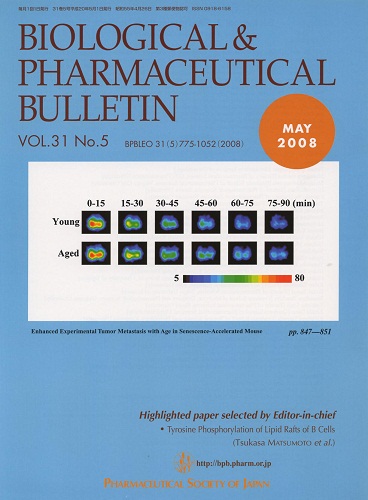All issues

Volume 31, Issue 5
Displaying 51-54 of 54 articles from this issue
Notes
-
Yukinobu Kodama, Shintaro Fumoto, Junya Nishi, Mikiro Nakashima, Hitos ...Article type: Notes
Subject area: Biopharmacy
2008 Volume 31 Issue 5 Pages 1049-1052
Published: May 01, 2008
Released on J-STAGE: May 01, 2008
JOURNAL FREE ACCESSThe present study was undertaken to elucidate the absorption and distribution characteristics of 5-fluorouracil (5-FU) after its application to the liver surface in rats to examine the possibility of reducing the systemic side effects of this agent. 5-FU was applied to the surface of the liver by employing a cylindrical diffusion cell. Approximately 69% of the dose was absorbed in 360 min. The time course of the change in the amount of 5-FU remaining in the diffusion cell obeyed first-order kinetics. Also, a linear relationship was observed between the apparent permeability coefficient, Papp, and the reciprocal of the square root of the molecular weight of several compounds including 5-FU. The estimated Papp value of 5-FU was in good agreement with the experimental value. The plasma concentration of 5-FU was low (<1.2 μg/ml) until 360 min after the application. Following i.v. administration, 5-FU was rapidly eliminated from the plasma and could not be detected at 120 min. In the analysis of tissue distribution, the liver was divided into three sites; the region under the diffusion cell attachment site (site 1), the treated lobe excluding site 1 (site 2), and untreated lobes (site 3). After being administered i.v., 5-FU mainly distributed in the kidney, and the concentration in the liver was significantly lower than that in kidney, spleen, or heart. After its application to the liver surface, however, 5-FU preferentially distributed at site 1, and was not detected at the other sites or in other tissues. Thus, these results suggested the possibility of a reduction in the systemic side effect of 5-FU on its application to the liver surface.View full abstractDownload PDF (95K)
Miscellaneous
Regular Articles
-
Yumi Cho, Kyu-Hoi Kim, Jae-Seok Shim, Jae-Kwan HwangArticle type: Regular Articles
Subject area: Miscellaneous
2008 Volume 31 Issue 5 Pages 986-989
Published: May 01, 2008
Released on J-STAGE: May 01, 2008
JOURNAL FREE ACCESSThe aim of this study was to investigate the in vitro inhibitory effects of macelignan isolated from Myristica fragrans HOUTT. on melanogenesis and its related enzymes such as tyrosinase, tyrosinase-related protein-1 (TRP-1), and tyrosinase-related protein-2 (TRP-2) in melan-a murine melanocytes. The IC50 values of macelignan for melanogenesis and tyrosinase were 13 μM and 30 μM, respectively, while those of arbutin as a positive control were 990 μM and 660 μM, respectively. In Western blot analysis, macelignan also significantly decreased tyrosinase, TRP-1, and TRP-2 protein expression. These results indicate that macelignan effectively inhibits melanin biosynthesis and thus could be employed as a new skin-whitening agent.View full abstractDownload PDF (166K) -
Yoshie Maitani, Sayaka Katayama, Kumi Kawano, Akihiro Hayama, Kazunori ...Article type: Regular Articles
Subject area: Miscellaneous
2008 Volume 31 Issue 5 Pages 990-993
Published: May 01, 2008
Released on J-STAGE: May 01, 2008
JOURNAL FREE ACCESSCamptothecin (CPT) has anticancer activity. While only the lactone form of CPT is biologically active, this form exhibits poor aqueous solubility. Pharmaceutical formulation of CPT incorporated in liposomes is of significant importance to develop the therapeutic utilization of CPT. The aim of this study was to increase incorporation efficiency and stability of CPT in liposomes composed of hydrogenated soybean phosphatidylcholine, cholesterol, and oleic acid (7 : 3 : 1, molar ratio), by incorporating three kinds of artificial lipids (DBs) (DB-liposome); 4-n-(M12B), 3,5-bis(B12B) and 3,4,5-tris(dodecyloxy)benzoic acid (T12B). The interaction of CPT with DB in the state of liposomes, was examined. In DB-liposomes presenting mean diameters of 150 nm, incorporation efficiency of CPT up to 55% and final drug to lipid molar ratio up to 0.07 were obtained when the liposomes were prepared at a feeding ratio of 1/30 (w/w) CPT/total lipid. However, in the optimal formulations, incorporated DB mol% was different; T12B and D12B were incorporated about one third and half mol% of M12B, respectively. Moreover, we demonstrated that T12B stabilized CPT in liposomes significantly compared with other DBs as measured by CPT release, and by steady state fluorescence polarization degree of CPT using intrinsic fluorescence of CPT. These findings suggested that in addition of contribution of phenyl group of DB, dodecyloxy group may interact strongly with lactone ring of CPT. The capacity to contain CPT interacted with DBs may be limited in liposomes. T12B may be incorporated in the interior of the bilayers, resulting in increase of incorporation stability of CPT. This finding demonstrates a potential application of the novel liposome formulation of CPT in drug delivery.View full abstractDownload PDF (129K) -
Chikara Yamauchi, Wataru Okazaki, Tadashi Yoshida, Aya KarasawaArticle type: Regular Articles
Subject area: Miscellaneous
2008 Volume 31 Issue 5 Pages 994-997
Published: May 01, 2008
Released on J-STAGE: May 01, 2008
JOURNAL FREE ACCESSProtease degradation of matrix (Ma) protein and microfibril (Mf) protein, which are the major components of human hair, were investigated. Ma or Mf protein was partially extracted from human hair and four types of keratins were prepared: Ma film, Mf film, Ma-rich fiber, and Mf-rich fiber. Of the two keratin films treated with protease, Mf film showed much higher degradation than Ma film. Of the two keratin fibers treated with protease, Mf-rich fiber showed much higher degradation than Ma-rich fiber. Protease potently degraded Mf protein. Furthermore, there was a high correlation between the extent of degradation and the water absorption of keratins.View full abstractDownload PDF (350K)